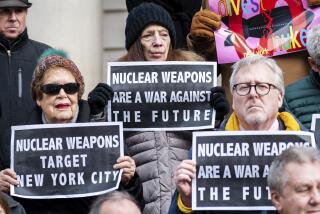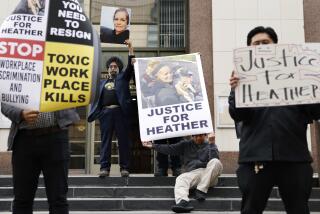U.N. Nuclear Inspection: Can It Really Work?
- Share via
VIENNA — United Nations nuclear inspectors are earning widespread respect these days, but they were not always so dynamic and daring.
For almost a year now, a series of dramatic images have impressed the world: U.N. inspectors whirling across Iraq by helicopter to surprise scientists desperately trying to cloak their secret machinery for making the fuel that can power bombs of hellish destruction. Undaunted by bullets and guards, the inspectors gather the blueprints, accounts and notebooks that prove Saddam Hussein’s intention to produce his bomb.
When the Iraqis balk, the U.N. Security Council bellows a stern warning, Washington hints of an air strike and the Iraqis give way to the eager teams of inspectors.
But not so very long ago, U.N. nuclear inspections were far different. The contrast, in fact, raises the grave question of whether inspections can ever really work, except in a country like Iraq that has been devastated and ravaged by war. And without adequate inspections, there is no realistic way to control nuclear proliferation.
Before the Persian Gulf War, a single inspector from the U.N. International Atomic Energy Agency would show up in Iraq twice a year. His visit announced long in advance, he would find an Iraqi official waiting for him at the airport. The Iraqis, in fact, could veto the selection of a particular inspector; they usually refused visas to any inspector without a Soviet or East European passport.
Accompanied always by his Iraqi minder, even at lunch and dinner in the Dian Hotel, the U.N. inspector would spend two days at most in Baghdad, checking three reactors, measuring nuclear fuel and looking into the contents of a storage shed, all on the enormous Tuwaitha government nuclear installation a few miles outside the capital.
One small Russian reactor produced 6 grams (one-fifth ounce) of plutonium--a fuel used in nuclear bombs and nowhere else--during this era of routine inspections. But if any inspector noticed, he did not report it because the IAEA inspectors were instructed to worry about plutonium only in amounts greater than 8 kilograms (17 1/2 pounds).
Elsewhere on the compound, the Iraqis covertly manufactured enriched uranium--another kind of fuel for nuclear bombs--with a sophisticated and complex centrifuge system that whipped the volatile and radioactive uranium isotope U-235 out of uranium ore.
The machinery had been smuggled from Europe and set up under the supervision of at least one German engineer. But no inspector ever came upon this plant. It was not their job to snoop around. Inspectors looked only at the nuclear facilities and materials that Iraq admitted possessing.
Every year, the IAEA certified that its inspectors “did not detect any event” in Iraq--or in any other country subject to inspections--that indicated that it was diverting its nuclear material “for the manufacture of any nuclear weapon or any other military purpose.”
“It is considered reasonable to conclude,” the agency would add every year, that Iraq and all other countries under inspection were involved “in peaceful nuclear activities.”
These reassuring assessments of Iraq have proven an embarrassment. The old inspections were a sham. But has the experience taught the United Nations enough to mount meaningful inspections in the future?
Most specialists agree that nuclear proliferation can be limited only through a combination of programs: the Nuclear Non-Proliferation Treaty of 1968; the export controls adopted by the industrialized countries, and regional political settlements in which hostile countries pledge not to use nuclear arms.
But all these programs depend on inspections to make them work.
North and South Korea, for example, signed an agreement at the end of 1991 to prohibit all nuclear bombs on their peninsula. But that kind of agreement amounts to no more than empty rhetoric unless future inspectors have the authority and expertise to verify that neither side is cheating.
Here in Vienna, Hans Blix, the IAEA’s 63-year-old director general, insists that only a lack of information prevented his inspectors from uncovering the truth about Iraq in the past. Once that information was supplied after the Gulf War--evidently by the CIA--his inspectors managed to uncover the truth, Blix said.
“I’m not ready to accept that this was a failure of the system,” Blix, a former Swedish foreign minister, said in a recent interview. He insisted that it is unfair to expect his inspectors to uncover an operation that even American intelligence had failed to detect before the Gulf War.
“Neither our inspectors nor any other inspectors can go like heroin dogs sniffing through every kilometer of a country,” he said. “You must hence have some information about where you should go--a building, a city--to search.”
In the case of post-war Iraq, the U.N. inspectors, armed with CIA information culled from an Iraqi defector, knew where to go and what to look for. That vital intelligence, according to Blix, made the difference between what seemed like perfunctory inspections in the past and what seem like dashing adventures now.
Some inspectors, however, look on Blix’s appraisal as an oversimplification of the problem. In their view, the U.N. agency never regarded itself as a policeman.
“If I had hinted 18 months ago that I was getting any information from any intelligence agency,” said Leslie Thorne, a veteran IAEA inspector from Britain, “my neck would have been wrung.”
Thorne, who has joined several of the postwar Iraqi inspections, sees more fundamental difficulties in the past than a lack of information. “Everybody has woken up to the fact,” he said, “that the existing system was never designed to uncover the Iraqi situation.”
Blix insists that he is not sticking to the old ways. He told the agency’s board of governors in early December that he agreed with critics who demanded that “better guarantees . . . be offered against surprises” such as the Iraqi nuclear program.
To deal with this, he proposed that the agency invoke its rarely used power to stage “special inspections” and that the IAEA create a new office to compile information about nuclear programs from intelligence agencies and other sources.
Under the Nuclear Non-Proliferation Treaty, the IAEA routinely inspects 45 countries with peaceful nuclear programs to make sure they are not diverting the equipment and fuel to military use. If unsatisfied, the agency has the right to a special inspection, but, in fact, it has made only a half-dozen in the last 20 years.
And these were imposed not to search for anything new or hidden but only to recheck the amount of fuel in a reactor or a storage area. All such searches ended with the inspectors reassured that nothing was wrong. Most critics regard this desultory use of special inspections as a lost opportunity.
Under the new Blix proposals, the special inspectors, armed with intelligence from the information office, could demand to go anywhere in a country. If the government balked, the IAEA would complain to the U.N. Security Council, setting up the kind of confrontation that most Third World countries prefer to avoid.
Sources said the Blix proposals met some resistance from several Third World members of the IAEA board who protested that the new information office and the system of extensive inspections might be used by the industrialized nations to hamper poorer countries from developing nuclear energy programs for peaceful use.
Nevertheless, Blix expects to implement the proposals. Some experts, however, doubt that they will guarantee adequate inspections.
David A. Kay, the U.S. inspector who led the IAEA team that was held hostage for four days in the parking lot of the Iraqi atomic energy commission in Baghdad last September, outlined the issues clearly in a recent interview at the IAEA’s Vienna headquarters.
“The problem with saying, ‘If you get the information, you’ll go,’ is that information is ambiguous and often wrong,” Kay said. “If I were North Korea, I would feed wrong information and then have a sudden inspection, which would find nothing. Can you imagine going into Algeria three times, finding nothing and then going back for a fourth inspection? More often than not, you’d be floundering around.”
Robert Gallucci, the State Department official who is vice chairman of the U.N. Special Commission on Iraq, has warned that future inspectors cannot expect to deal with other countries the way they dealt with postwar Baghdad. The special commission is charged with ridding Hussein’s defeated regime of all its programs of mass destruction, including chemical and biological as well as nuclear weapons.
The Iraqi experience indicates that it probably will not be enough to arm U.N. inspectors with secret intelligence. A viable inspection system demands that inspectors look on themselves as police officers and that governments accept the principle of sudden, extensive inspections. The Blix proposals do not seem to go to the heart of the matter.
The IAEA’s Vienna headquarters are probably the least-known of U.N. buildings, usually far out of the limelight. But excitement coursed through the modern office blocks along the Danube River in early December when both President Carlos Saul Menem of Argentina and President Fernando Collor de Mello of Brazil and their entourages arrived to sign a joint nuclear agreement in the offices of Director General Blix.
Longtime rivals in South America, both countries, when under military rule in the 1970s and early 1980s, had started nuclear weapons programs. While neither has produced nuclear fuel for weapons, both have the facilities to do so. But their civilian governments have now pledged to give up nuclear military ambitions, and the agreement signed by Menem and Collor allows inspections by both the IAEA and each other to make sure that the pledge is kept.
IAEA excitement over the agreement reflected a feeling there and among specialists elsewhere that the key to controlling nuclear proliferation lies with the realization by individual governments that it is foolish to get involved in a nuclear arms race.
For that reason, many officials are hailing the recent decision by South Africa to accept IAEA inspections. And, although many skeptics are convinced that North Korea intends to produce a nuclear bomb, specialists are still carefully watching the negotiations between North and South Korea on nuclear weapons.
Gary Milhollin, director of the Wisconsin Project on Nuclear Arms Control, believes that both Argentina and Brazil decided that their nuclear weapons programs were not worth the cost.
In the long run, Milhollin said, the Argentine-Brazil example will be followed by antagonists such as Pakistan and India. “I personally think they will decide they can’t eat bombs for breakfast,” he said. “Sooner or later, you have to choose between bombs and breakfast cereal.
“That’s how I think the problem will be solved eventually. People will trade bombs for butter because they need butter a lot.”
But persuasion is not easy, especially when fears are interlocking.
Also, all agreements between antagonists need more than goodwill to work. The parties will have confidence in each other only if they have faith in inspections. To merit this faith, inspections will have to be strengthened beyond what the IAEA’s Blix has proposed so far.
“I’m not so optimistic about inspections,” said IAEA inspector Thorne. “But there’s no other answer.”
More to Read
Sign up for Essential California
The most important California stories and recommendations in your inbox every morning.
You may occasionally receive promotional content from the Los Angeles Times.










